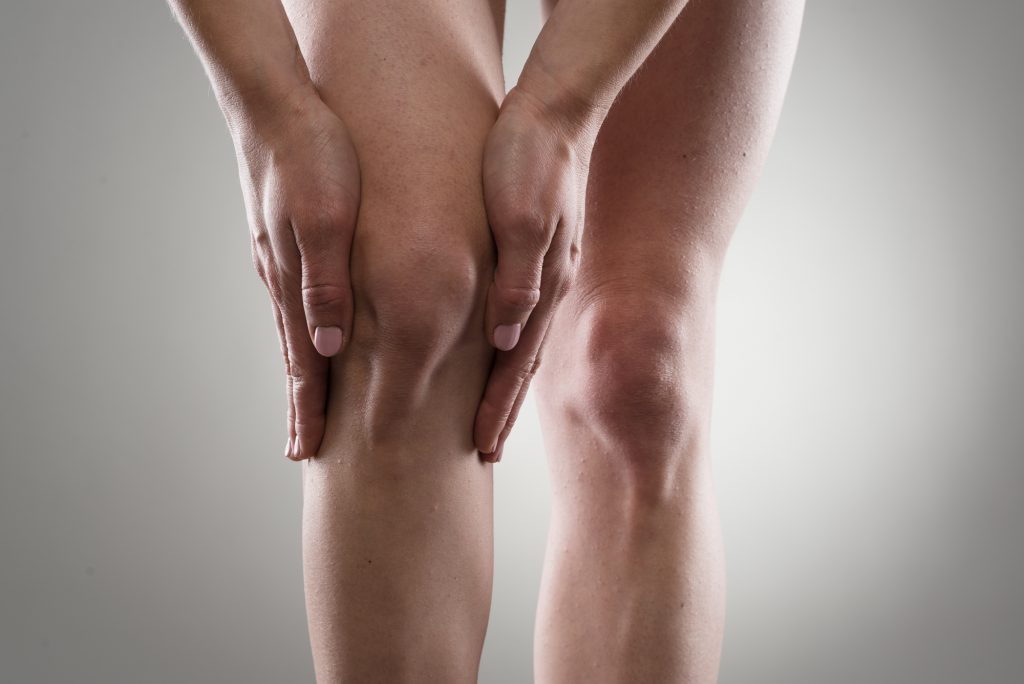Loud clicking noises and small ‘pops’ and ‘cracks’ in your knees can be both worrying and disconcerting. It’s common for people to think that noises coming from their knees can be a sign of joint damage or even a sign of bones rubbing against each other within their knees. However, you’ll be pleased to hear that in the majority of cases, noisy knees are absolutely nothing to worry about and can normally be put down to either what is known as joint cavitation or crepitus.

Clicking in knees is normally cavitation or crepitus
What Causes Noisy Knees?
More often than not, a noise coming from your knee is due to what is known as cavitation. When a joint moves a pressure change occurs within the joint which can lead to the release of gas from within the joint. This can result in an audible popping or clicking sound. A good example is bending or straightening your knee, for example when getting up out of a chair. As your knee moves from a bent, flexed position to a straight, extended position the pressure change can lead to cavitation. Crepitus can also occur within the knee which can feel like a clicking, grinding, or crackling sensation. Often these noises can feel strange but are normally pain free. However, sometimes crepitus can be associated with pain. Patellofemoral crepitus is extremely common. One study examined 247 symptomatic knees and compared them to 250 normal, pain free knees. The research found that 99% of normal subjects who had zero knee pain still had patellofemoral crepitus (McCoy et al, 1987). This indicates that crepitus is extremely common and is normally nothing to worry about.
Whilst it is commonly thought that cavitation and crepitus are caused by the release of gas bubbles within the synovial fluid within a joint, there can be other causes behind the noises in your knee. It has been proposed that noises within the knee could be caused by the movement of fluid within the joint, in particular through the patellofemoral joint. Snapping of ligaments and tendons over bony prominences can also give rise to a sensation of popping and cracking. If you’re hypermobile then the joints around your body can also be noticeably more click-y as opposed to someone who isn’t hypermobile. The difficulty with noisy knees is that people often worry that the noises they hear is caused by bony or tissue damage within the knee yet most of the time this isn’t the case at all. However, if noisy clicks or popping sounds in a knee joint are also accompanied by pain then a knee injury might exist such as a meniscus tear.
What Does the Research Say?
Recent research into clicking knees has found that having crepitus in the knee does not have an adverse effect on knee health. A study by de Oliveria Silva et al in 2018 concluded that women with patellofemoral pain are four times more likely to have knee crepitus. However, notably, crepitus in the knee does not have a negative effect on knee function, level of physical activity or pain when squatting or climbing stairs. Further research has also found that in women with patellofemoral pain, the existence of crepitus has no impact upon both the objective and subjective assessment of the knee joint. In other words, crepitus does not significantly contribute to patellofemoral knee pain.
Research indicates that the presence of crepitus can be associated with the presence of osteoarthritic change within the patellofemoral joint. However, it has been found that crepitus does not indicate any osteoarthritic change within the tibiofemoral joint (Schiphof et al, 2014). A more recent study in 2019 assessed a large subject group to examine the implications of knee crepitus on knee osteoarthritis. The study examined 4000 knees and found that even if knee crepitus exists, its presence does not increase the chances of needing a total knee replacement in the next thirty-six months (Pazzinatto et al, 2019). The presence of crepitus has been shown to slightly reduce knee extension strength yet the declines in strength do not affect physical function or quality of life in the long term (Pazzinatto et al, 2019). This means that even if you have crepitus in your knee it does not mean that you will have reduced function as a result. Typically, with many conditions, the symptoms you feel do not always match the level of function or impairment you have. It is therefore suggested that even though crepitus does not add to physical impairment, people may be limited by their own negative beliefs regarding it. Many people can become fearful and concerned about the noises caused by crepitus and believe that their condition is actually worse than it is. Crepitus can therefore impede your function if you have negative feelings towards it.

Do I Need to Get It Treated?
The short answer is no. If your knee makes a few popping or clicking noises then there is nothing to be concerned about. Aim to keep moving and stay physically active. It is important to realise that noisy knees are not normally a sign of injury but understanding this is critical because negative feelings and inaccurate beliefs about crepitus can lead to altered behaviour (Robertson et al, 2017).
Provided the noise in your knee is pain free there is no need to see a physiotherapist about it. However, if any crepitus is associated with pain or a history of trauma then it is important to seek treatment. Notably, when seeking treatment it is not the noise caused by crepitus that is the issue – instead it will be the underlying pathology which will require treatment (Song et al, 2018).
If you are struggling with clicking in your knee which is accompanied by pain or injury then please get in touch with us for an appointment so that we can assess and treat your knee in full.
References:
De Oliveira Silva, D., Barton, C., Crossley, K., Waiteman, M., Taborda, B., Ferreira, A. S., & Azevedo, F. M. (2018). Implications of knee crepitus to the overall clinical presentation of women with and without patellofemoral pain. Physical Therapy in Sport, 33, 89-95.
De Oliveira Silva, D., Pazzinatto, M. F., Priore, L. B., Ferreira, A. S., Briani, R. V., Ferrari, D., Bazett-Jones, D., & Azevedo, F. M. (2018). Knee crepitus is prevalent in women with patellofemoral pain, but is not related with function, physical activity and pain. Physical Therapy in Sport, 33, 7-11.
Pazzinatto, M. F., De Oliveira Silva, D., Azevedo, F. M., & Pappas, E. (2019). Knee crepitus is not associated with the occurrence of total knee replacement in knee osteoarthritis – a longitudinal study with data from the osteoarthritis initiative. Brazilian Journal of Physical Therapy, 23(4), 329-336.
Pazzinatto, M. F., De Oliveira Silva, D., Faria, N. C., Simic, M., Ferreira, P. H., Azevedo, F. M., & Pappas, E. (2019). What are the clinical implications of knee crepitus to individuals with knee osteoarthritis? An observational study with data from the osteoarthritis initiative. Brazilian Journal of Physical Therapy, 23(6), 491-496.
Robertson, C. J., Hurley, M., & Jones, F. (2017). People’s beliefs about the meaning of crepitus in patellofemoral pain and the impact of these beliefs on their behaviour: A qualitative study. Musculoskeletal Science and Practice, 28, 59-64.
Schiphof D, Middelkoop van M, Klerk B.M, Oei E, Hofman A, Koes B, Weinans H, Bierma-Zeinstra S. (2014) Crepitus is a first indication of patellofemoral osteoarthritis (and not of tibiofemoral osteoarthritis). Osteoarthritis and Cartilage. 22. 631-638.
Song, S. J., Park, C. H., Liang, H., & Kim, S. J. (2018). Noise around the knee. Clinics in Orthopedic Surgery, 10(1), 1.
McCoy, G., McCrea, J., Beverland, D., Kernohan, W., & Mollan, R. (1987). Vibration arthrography as a diagnostic aid in diseases of the knee. A preliminary report. The Journal of Bone and Joint Surgery. British volume, 69-B(2), 288-293

